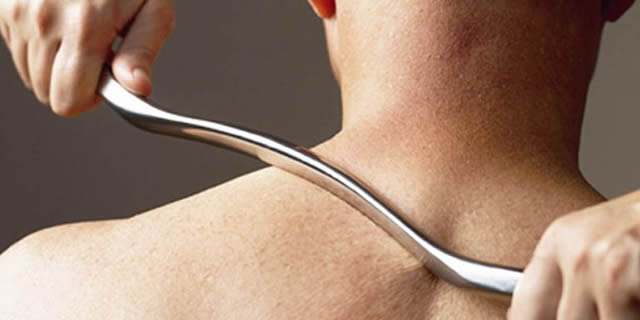What is IASTM?
IASTM has been dated back to ancient china where it was used as a form of manual therapy by scraping the skin with shaped animal horns, of ivory or bone.
In modern practice IASTM normally involves either stainless steel tools or tools using some sort of plastic. The tools are used to treat the muscles, tendons and ligaments of the body. It is similar to massage in a way, but can be more precise because of the stainless steel tools used in IASTM and is able to achieve results that traditional hands on massage alone would be unable to. Another benefit of using a stainless steel tool over a hand is that the tool carries a certain amount of resonation in it. Over an area of muscle which is tighter and more adhesive than the surrounding tissue, the resonance of the tool will cause the area to feel like there are coffee granules beneath the skin. This resonation allows a trained IASTM practitioner to pick up directions that specific muscle fibres are more adhesive in, which allows the treatment to be much more specific and therefore effective.
Misconceptions
One of the most common misconceptions among chiropractors, osteopaths or physiotherapists that use IASTM (without proper training) is you need to bruise the skin and create a reaction known as petechiae. This is because many practitioners think that bruising (petechiae) must be achieved for positive tissue change. More recent studies have shown you do not need to create petechiae to be successful in treatment as IASTM has shown to have numerous beneficial effects on the nervous system rather than just mechanical benefits to the tissues. However, I have found that using a mild (pain free), consistent pressure and stroke over a length of muscular tissue there will be localised petechiae only over an area of dysfunction (trigger point or fascial adhesion) and not over healthy tissue. You will only bruise healthy tissue with excessive pressure and extended duration of treatment. This suggests to me from my experience that there is a correlation between petechiae and therapeutic effect but should only be as a result of a pain free treatment and the practitioner should not go hunting for this reaction, if they are treating the correct area with the correct pressure then some will likely occur.
Forms of IASTM
One of the most common forms of IASTM is called Graston technique. This was a technique developed by a group of chiropractors in America. There has been a lot of research produced by the Graston foundation showing several positive affects. A famous Graston research papers was carried out on rat ligaments believe it or not... In this study, Graston technique was used on healing rat ligaments to see if it effected the structure of the healed ligament in any way. The results showed that the rat ligaments that received Graston technique healed in a much more organised and therefore stronger orientation, whereas the rat ligaments that didn't receive Graston technique healed with fibres running in all sorts of directions. This shows that for people that suffer a joint sprain for example, IASTM can be used to help improve the healing time and also improve the outcomes once the healing has finished.
Another way to use IASTM is to reduce the tightness of tissues or muscles. Sometimes tight muscles are caused by overfiring of the nervous system, which is responding too much to a certain stimulus. By gently using the IASTM tool over an area that is being overstimulated, this overstimulation can be reduced and the muscle can go back to a more relaxed state. The soft tissue of the body has several different receptors within it, one of which is called a mechanoreceptor. This type of receptor senses pressure, and sends signals back to the central nervous system which then decides what to do next. There are both slow response mechanoreceptors as well as fast response mechanoreceptors. Both of these types of mechanoreceptor respond well to different types of IASTM.

Hopefully this review of IASTM has not been too scientific. At the end of the day, it is just another soft tissue technique utilised by me to help reduce pain and improve mobility.

